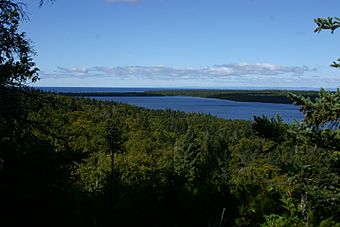Minong Traditional Cultural Property facts for kids
Quick facts for kids |
|
|
Minong
|
|

Siskiwit Bay
|
|
| Location | Isle Royale National Park, Michigan |
|---|---|
| Area | 189,665 acres (76,755 ha) [133,788 acres (54,142 ha) land and 55,877 acres (22,613 ha) water] |
| NRHP reference No. | 100003341 |
| Added to NRHP | January 24, 2019 |
The Minong Traditional Cultural Property is a special place that was added to the National Register of Historic Places in 2019. Minong is the name the Ojibwe people use for Isle Royale. This listing officially recognizes the long and important connection the Grand Portage Band of Lake Superior Chippewa has with the island. The protected area includes the main island, all the smaller islands around it, and the traditional fishing waters nearby.
Contents
Minong: A Special Place for the Ojibwe
The Minong Traditional Cultural Property is a type of historic place. It is special because it is important to the culture and history of a Native American group. For the Grand Portage Band of Lake Superior Chippewa, Minong (Isle Royale) is a place they have used for a very long time.
A Long History of Use
Scientists have found old tools and signs that show the Ojibwe people used Minong for fishing and mining copper many, many years ago. It's not clear if these early people were from the Grand Portage Band or a related tribe. The first written record that confirms Ojibwe people on Minong is from around 1794. During this time, it was common for people to travel between the mainland and Minong.
As Europeans came to the area, the Ojibwe started trading furs and fish. They continued to fish on Isle Royale for food and for trade for many decades into the 1800s.
Continuing Traditions Today
Even in the 1900s, members of the Grand Portage Band kept using Minong. They hunted, fished, trapped, and made maple sugar for their families. They also used the island for business, like selling fish or furs. Some members even worked in the island's resorts and recreation areas.
This connection continues today. In 1971, the Grand Portage Band opened the Grand Portage Marina. This marina is a place where boats can leave from Grand Portage to go to Isle Royale National Park. People still go there for fishing and diving trips, keeping the traditions alive.
Important Natural Places on Minong
The special parts of the Minong Traditional Cultural Property are mostly natural places. These include harbors, bays, and other natural spots. They are not specific buildings or docks. These natural areas are places the Grand Portage Band traditionally used. They also include locations that are important to their history.
Key Natural Features
Some of these important natural places include:
- McCargoe Cove
- Todd Harbor
- Siskiwit Bay
- Checker Point
- Indian Point
- Grace Point and Island
- Sugar Mountain
- Greenstone Beach
- Chippewa Harbor
- Camelian Beach
- Rock Harbor
- Pickeral Cove
- Fishermans Home
- Washington Harbor
These places were used by the Grand Portage Ojibwe people for many activities. They worked as miners, fishermen, and tour guides. They also used these areas for other important cultural activities.
The Little Cedar Spirit Tree
The Minong Traditional Cultural Property also includes one special feature that is not on the island itself. This is the Little Cedar Spirit Tree, or Manito Geezhigaynce. It is located on the north side of Hat Point, which is on the Grand Portage Indian Reservation. This tree is also very important to the Grand Portage Band's traditions.



